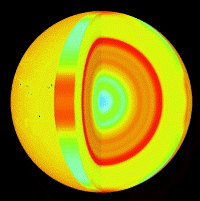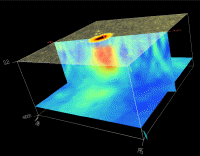Solar Interior
Three of SOHO's instruments give information about the interior of the Sun:
- MDI (Michelson Doppler Imager) measures wave motions at a million points. It is unique in its ability to explore details just below the visible surface.
- GOLF (Global Oscillations at Low Frequencies) observes the whole Sun oscillating by detecting velocity changes. It can explore all the way down to the Sun's core.
- VIRGO (Variability of Solar Irradiance and Gravity Oscillations) sees variations in the Sun's brightness from minute to minute, associated with the oscillations.
Q & A on the solar interior
 |
|
MDI and VIRGO measured radial and latitudinal variations in sound waves inside the Sun |
How does gas move about inside the Sun?
The fast surface rotation seen in the equatorial zone continues down to the core, as gauged by MDI. At mid-latitudes, MDI found the gas moving faster than at the surface, producing a shear layer (with difference in motion) just below the surface.
Other discoveries from MDI include sub-surface jet streams near the poles, where gas moves faster than its surroundings, and a slow sub-surface current of gas flowing from the equator towards the poles.
Deep inside the Sun, 170 000 to 230 000 km beneath the visible surface, a turbulent region separates the outer convective layer from an inner radiative layer. The rotation rate falls off as one goes deeper, and the shear may drive the dynamo that generates the ever-changing magnetic field seen at the surface.
 |
|
The subsurface structure (sound speed) below a sunspot as derived from Doppler measurements by MDI |
How deep are the features seen at the Sun's surface?
Roots of sunspots, revealed by MDI, show a cool layer near the surface, and under that a column of hot, magnetized gas extending 4000 to 20 000 km deep into the interior beneath a sunspot.
The spot-free regions of the Sun are covered with gas bubbles, or granules. These are typically about 2000 km wide and grouped in supergranules about 30 000 km wide. Before SOHO, theorists expected the supergranules to be 15 000 to 20 000 km deep, but MDI shows them to be shallower than expected, 5000 to 8000 km deep.
Are SOHO's revelations about the interior surprising?
When scientists put together the results of MDI, GOLF and VIRGO they find broad agreement with their theory of stars, but subtle differences too. The temperature at the bottom of the turbulent convective zone is higher than predicted - the result of an unconsidered stirring action that brings up helium gas from the lower regions. The Sun's core, on the other hand, is cooler than expected, implying that the core and its nuclear reactor are more complicated than the standard theory suggests.
Are other kinds of waves detectable?
Oscillations studied so far are all sound waves, but there should also be gravity waves in the Sun, with up-and-down motions like waves in the sea. A reference to gravity oscillations in the name of VIRGO expressed the scientists' hope of finding them. However, even when they combine VIRGO and MDI data with ground-based observations, looking for motions as slow as one centimetre per second, the gravity waves remain undetected. The search continues.
Listen to the Sun
The solar sound waves are far too low in pitch for human hearing, but conversion to the audible range gives an impression of the sounds of the Sun. Listen to the sounds of the Sun at the site of the Solar Oscillations Investigations (SOI) group at Stanford University (see 'related links').
